|
|
St Meletius, Archbishop of Antioch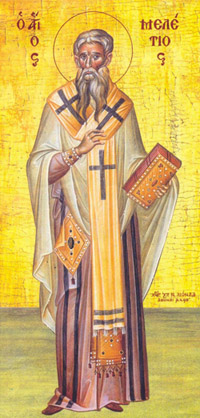 This great and holy man was an outstanding interpreter and defender of Orthodoxy. The whole of his life was devoted to the fight against the Arian heresy, which did not recognise the Son of God and blasphemed against the Holy Trinity. He was three times removed from his archiepiscopal throne by the heretics, and driven off into Armenia. The struggle between the Orthodox and the heretics became so bitter that once, while St Meletius was preaching to the people in church on the divine Trinity in unity, his own deacon, a heretic, ran up to the bishop and shut his mouth with his hand. Being unable to preach with words, Meletius preached by signs. Thus, he raised his arms on high, opened three fingers to their fullest extent and showed them to the people, then closed his hand and raised the one fist. He took part in the Second Ecumenical Council in 381, where the Emperor Theodosius showed him specially great honour. At that Council, God showed a mystery through His archbishop. When Meletius was propounding the doctrine of the Holy Trinity to the Arians, he first raised three fingers, separated one by one, then brought them together; and at that moment lightning flashed from his hand before the gaze of all present. At that Council, Meletius established Gregory the Theologian in the seat of Constantinople. While the Council was still in session, St Meletius finished his earthly course in Constantinople. His relics were taken to Antioch. This great and holy man was an outstanding interpreter and defender of Orthodoxy. The whole of his life was devoted to the fight against the Arian heresy, which did not recognise the Son of God and blasphemed against the Holy Trinity. He was three times removed from his archiepiscopal throne by the heretics, and driven off into Armenia. The struggle between the Orthodox and the heretics became so bitter that once, while St Meletius was preaching to the people in church on the divine Trinity in unity, his own deacon, a heretic, ran up to the bishop and shut his mouth with his hand. Being unable to preach with words, Meletius preached by signs. Thus, he raised his arms on high, opened three fingers to their fullest extent and showed them to the people, then closed his hand and raised the one fist. He took part in the Second Ecumenical Council in 381, where the Emperor Theodosius showed him specially great honour. At that Council, God showed a mystery through His archbishop. When Meletius was propounding the doctrine of the Holy Trinity to the Arians, he first raised three fingers, separated one by one, then brought them together; and at that moment lightning flashed from his hand before the gaze of all present. At that Council, Meletius established Gregory the Theologian in the seat of Constantinople. While the Council was still in session, St Meletius finished his earthly course in Constantinople. His relics were taken to Antioch.St Alexis, Metropolitan of Moscow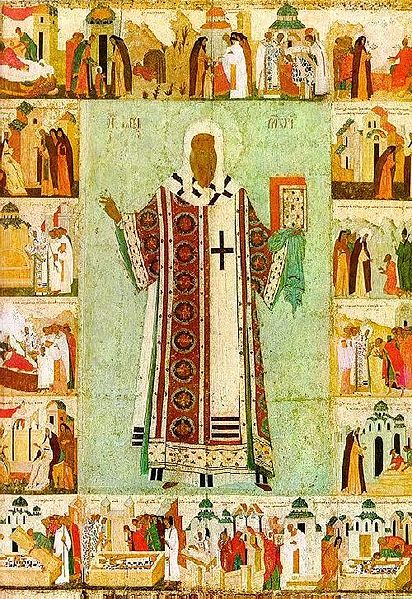 A great hierarch of the Russian Church in a difficult period of Tartar oppression of the Russian people. Once in childhood he went bird hunting, then went to sleep and in a dream heard a voice that said: "Alexis, why rush around so fruitlessly? I will teach you to catch men!" He became a monk at the age of twenty, and in time became Metropolitan of Moscow. He twice went among the" Golden Horde" of the Tartars, once to sooth the wrath of Verdevir Khan against the Russian people, and the second time at the invitation of Amurat Khan, to cure his wife"s blindness. This-women had been blind for three years, but was healed and her vision restored when Alexis prayed and anointed her with holy water. After a life of great endeavour and fruitfulness, Alexis entered into rest in 1378 at the age of 85, and went to the court of the Lord. A great hierarch of the Russian Church in a difficult period of Tartar oppression of the Russian people. Once in childhood he went bird hunting, then went to sleep and in a dream heard a voice that said: "Alexis, why rush around so fruitlessly? I will teach you to catch men!" He became a monk at the age of twenty, and in time became Metropolitan of Moscow. He twice went among the" Golden Horde" of the Tartars, once to sooth the wrath of Verdevir Khan against the Russian people, and the second time at the invitation of Amurat Khan, to cure his wife"s blindness. This-women had been blind for three years, but was healed and her vision restored when Alexis prayed and anointed her with holy water. After a life of great endeavour and fruitfulness, Alexis entered into rest in 1378 at the age of 85, and went to the court of the Lord.Our Holy Mother Mary (Marius)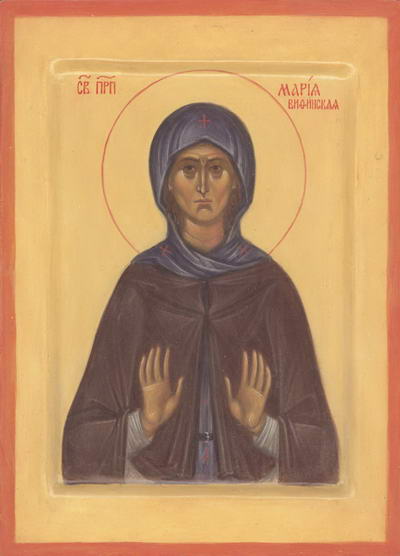 Mary was a woman with a man's courage. After the death of her mother, her father desired to become a monk. Mary would not be separated from him, so they decided to go together to a men"s monastery - Mary with short hair and in man"s raiment as a youth. Her father died, and Mary became a monk and received the name Marius. There was an inn near the monastery, and the innkeeper's daughter fell in love with the pious monk Marius. After pursuing him without success, she accused Marius of unlawful relations with her, because she had known some other man and borne him a son. Mary did not defend herself and was driven forth with scorn from the monastery. With the strange child in her care, she lived for three years in a grove belonging to the monastery, enduring hunger and hatred, and every sort of hardship and privation. As a result of all this, the innkeeper's daughter became deranged and, a little later, Mary died. Immediately after her death it was discovered that the "Monk Marius" was a woman. As soon as the innkeeper"s daughter touched the relics of St Mary, she was healed of her insanity and confessed her terrible sin. St Mary entered into rest and went to eternal joy in 508. Mary was a woman with a man's courage. After the death of her mother, her father desired to become a monk. Mary would not be separated from him, so they decided to go together to a men"s monastery - Mary with short hair and in man"s raiment as a youth. Her father died, and Mary became a monk and received the name Marius. There was an inn near the monastery, and the innkeeper's daughter fell in love with the pious monk Marius. After pursuing him without success, she accused Marius of unlawful relations with her, because she had known some other man and borne him a son. Mary did not defend herself and was driven forth with scorn from the monastery. With the strange child in her care, she lived for three years in a grove belonging to the monastery, enduring hunger and hatred, and every sort of hardship and privation. As a result of all this, the innkeeper's daughter became deranged and, a little later, Mary died. Immediately after her death it was discovered that the "Monk Marius" was a woman. As soon as the innkeeper"s daughter touched the relics of St Mary, she was healed of her insanity and confessed her terrible sin. St Mary entered into rest and went to eternal joy in 508.St Antony, Patriarch of Constantinople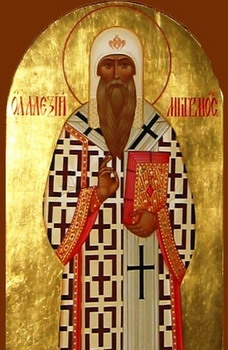 He was at first an ascetic, a man of great compassion, and then Patriarch in the time of the Emperor Leo the Wise (889-912). he proffesed his father monk and build a monastery over the relics of St Callia. He was at first an ascetic, a man of great compassion, and then Patriarch in the time of the Emperor Leo the Wise (889-912). he proffesed his father monk and build a monastery over the relics of St Callia.St CalliaCallia was generous to poor from pure Christian compassion, both as a young girl and later as a married women. Her husband was rich but a hard man. Returning on one occasion from his work, he found that his wife had given away all his wealth to the poor. He thereupon killed her. But God glorified this compassionate soul, in that her relics healed many of the sick. Convinced by this of her sanctity, the holy patriarch Antony build a monastery over her relics.
Icon of the Mother of God “Iveron”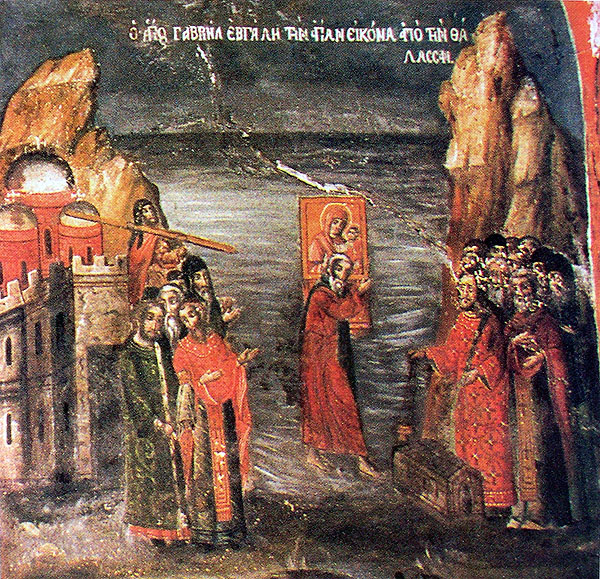 During the reign of Emperor Theophilus (829-842) the Byzantine Empire raged with the heresy of iconoclasm. In accordance with the emperor’s command, thousands of soldiers pillaged the empire, searching every corner, city, and village for hidden icons.
Near the city of Nicaea there lived a certain pious widow who had concealed an icon of the Most Holy Theotokos. Before long the soldiers discovered it, and one of them thrust his spear into the image.
But by God’s grace his terrible deed was overshadowed by a miracle: blood flowed forth from the wound on the face of the Mother of God.
The frightened soldiers quickly fled.
The widow spent the whole night in vigil, praying before the icon of the Most Holy Theotokos. In the morning, according to God’s will, she took the icon to the sea and cast it upon the water. The holy icon stood upright on the waves and began to sail westward.
Time passed, and one evening the monks of the Iveron Monastery on Mt. Athos beheld a pillar of light, shining upon the sea like the sun (ca. 1004). The miraculous image lasted several days, while the fathers of the Holy Mountain gathered together, marveling. Finally they descended to the edge of the sea, where they beheld the pillar of light standing above the icon of the Theotokos. But when they approached it, the icon moved farther out to sea.
At that time a Georgian monk named Gabriel was laboring at the Iveron Monastery. The Theotokos appeared to the fathers of the Holy Mountain and told them that Gabriel alone was worthy to retrieve the holy icon from the sea. At the same time, she appeared to Gabriel and told him, “Enter the sea, and walk out upon the waves with faith, and all will witness my love and mercy for your monastery.”
The monks of Mt. Athos found Gabriel at the Georgian monastery and led him down to the sea, chanting hymns, and censing with holy incense. Gabriel walked out upon the water as though upon dry land, took the icon in his arms, and obediently carried it back to shore.
This miracle occurred on Bright Tuesday.
While the monks were celebrating a paraklesis of thanksgiving, a cold, sweet spring miraculously gushed forth from the ground where the icon stood. Afterwards they took the icon to a church and set it down in the sanctuary with great reverence.
But the next morning one of the monks came to light a lamp and discovered that the icon was no longer where they had left it; now it was hanging on a wall near the entrance gate. The disbelieving monks took it down and returned it to the sanctuary, but the next day the icon was again found at the monastery gate. This miracle recurred several times, until the Most Holy Virgin appeared to Gabriel, saying, “Announce to the brothers that from this day they should not carry me away. For what I desire is not to be protected by you; rather I will overshadow you, both in this life and in the age to come. As long as you see my icon in the monastery, the grace and mercy of my Son shall never be lacking!”
Filled with exceeding joy, the monks erected a small church near the monastery gate to glorify the Most Holy Theotokos and placed the wonder-working icon inside. The holy icon came to be known as the “Iveron Mother of God” and, in Greek, Portaitissa. By the grace of the miraculous Iveron Icon of the Theotokos, many miracles have taken place and continue to take place throughout the world. During the reign of Emperor Theophilus (829-842) the Byzantine Empire raged with the heresy of iconoclasm. In accordance with the emperor’s command, thousands of soldiers pillaged the empire, searching every corner, city, and village for hidden icons.
Near the city of Nicaea there lived a certain pious widow who had concealed an icon of the Most Holy Theotokos. Before long the soldiers discovered it, and one of them thrust his spear into the image.
But by God’s grace his terrible deed was overshadowed by a miracle: blood flowed forth from the wound on the face of the Mother of God.
The frightened soldiers quickly fled.
The widow spent the whole night in vigil, praying before the icon of the Most Holy Theotokos. In the morning, according to God’s will, she took the icon to the sea and cast it upon the water. The holy icon stood upright on the waves and began to sail westward.
Time passed, and one evening the monks of the Iveron Monastery on Mt. Athos beheld a pillar of light, shining upon the sea like the sun (ca. 1004). The miraculous image lasted several days, while the fathers of the Holy Mountain gathered together, marveling. Finally they descended to the edge of the sea, where they beheld the pillar of light standing above the icon of the Theotokos. But when they approached it, the icon moved farther out to sea.
At that time a Georgian monk named Gabriel was laboring at the Iveron Monastery. The Theotokos appeared to the fathers of the Holy Mountain and told them that Gabriel alone was worthy to retrieve the holy icon from the sea. At the same time, she appeared to Gabriel and told him, “Enter the sea, and walk out upon the waves with faith, and all will witness my love and mercy for your monastery.”
The monks of Mt. Athos found Gabriel at the Georgian monastery and led him down to the sea, chanting hymns, and censing with holy incense. Gabriel walked out upon the water as though upon dry land, took the icon in his arms, and obediently carried it back to shore.
This miracle occurred on Bright Tuesday.
While the monks were celebrating a paraklesis of thanksgiving, a cold, sweet spring miraculously gushed forth from the ground where the icon stood. Afterwards they took the icon to a church and set it down in the sanctuary with great reverence.
But the next morning one of the monks came to light a lamp and discovered that the icon was no longer where they had left it; now it was hanging on a wall near the entrance gate. The disbelieving monks took it down and returned it to the sanctuary, but the next day the icon was again found at the monastery gate. This miracle recurred several times, until the Most Holy Virgin appeared to Gabriel, saying, “Announce to the brothers that from this day they should not carry me away. For what I desire is not to be protected by you; rather I will overshadow you, both in this life and in the age to come. As long as you see my icon in the monastery, the grace and mercy of my Son shall never be lacking!”
Filled with exceeding joy, the monks erected a small church near the monastery gate to glorify the Most Holy Theotokos and placed the wonder-working icon inside. The holy icon came to be known as the “Iveron Mother of God” and, in Greek, Portaitissa. By the grace of the miraculous Iveron Icon of the Theotokos, many miracles have taken place and continue to take place throughout the world. St Kristo the Gardener of Albania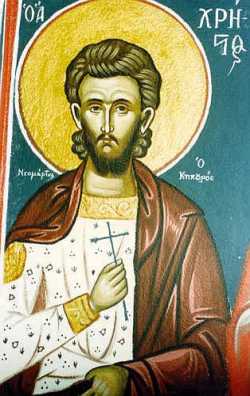 The holy New Martyr Kristo was an Albanian who worked in a vegetable garden. At the age of forty, he decided to go to Constantinople to seek better business opportunities.
One day he was negotiating with a Turk who wished to purchase his entire stock of apples, but they were unable to agree on a price. The Turk became angry and accused Kristo of expressing a desire to become a Moslem. Kristo was brought before the authorities, and false witnesses were found to testify that he had indeed stated his intention to convert.
Kristo declared that he never said that he wished to become a Moslem. His testimony was discounted, however, because he was a Christian, and Moslem witnesses had contradicted him.
The saint was beaten and tortured the next day, but remained steadfast in his confession of Christ. Kaisarios Dapontes, a well known monk and author, visited St Kristo and got him freed from the place where he was chained. He brought food for him, but he refused to eat. “Why should I eat?” he asked. “I do not expect to live, so I may as well die hungering and thirsting for Christ.”
Since he refused to abandon the Orthodox Faith, St Kristo was sentenced to be beheaded. Before they led him away, Kristo gave Dapontes a metal file and told him to sell it and use the money to have memorial services offered for him.
On February 12, 1748 St Kristo the Gardener was beheaded, thereby receiving an imperishable crown of glory from Christ. The holy New Martyr Kristo was an Albanian who worked in a vegetable garden. At the age of forty, he decided to go to Constantinople to seek better business opportunities.
One day he was negotiating with a Turk who wished to purchase his entire stock of apples, but they were unable to agree on a price. The Turk became angry and accused Kristo of expressing a desire to become a Moslem. Kristo was brought before the authorities, and false witnesses were found to testify that he had indeed stated his intention to convert.
Kristo declared that he never said that he wished to become a Moslem. His testimony was discounted, however, because he was a Christian, and Moslem witnesses had contradicted him.
The saint was beaten and tortured the next day, but remained steadfast in his confession of Christ. Kaisarios Dapontes, a well known monk and author, visited St Kristo and got him freed from the place where he was chained. He brought food for him, but he refused to eat. “Why should I eat?” he asked. “I do not expect to live, so I may as well die hungering and thirsting for Christ.”
Since he refused to abandon the Orthodox Faith, St Kristo was sentenced to be beheaded. Before they led him away, Kristo gave Dapontes a metal file and told him to sell it and use the money to have memorial services offered for him.
On February 12, 1748 St Kristo the Gardener was beheaded, thereby receiving an imperishable crown of glory from Christ. Martyrs Saturnius and Plotonus
Hieromartyr Urban us, bishop of Rome (223-230)
|